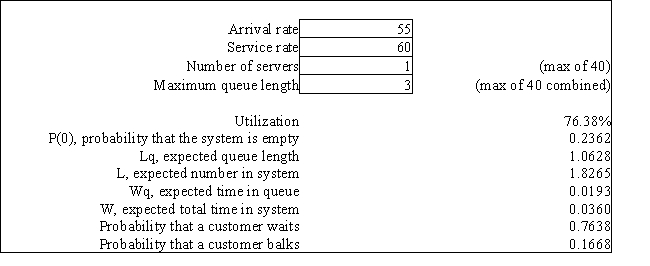Exhibit 13.5
The following questions refer to the information and output below.
A computer printer in a large administrative office has a printer buffer (memory to store printing jobs) capacity of 3 jobs. If the buffer is full when a user wants to print a file the user is told that the job cannot be printed and to try again later. There are so many users in this office that we can assume that there is an infinite calling population. Jobs arrive at the printer at a Poisson rate of 55 jobs per hour and take an average of 1 minute to print. Printing times are exponentially distributed. The following queuing analysis spreadsheet was developed from this information. 
-Refer to Exhibit 13.5. Based on this report what is the probability that a computer user will be told to resubmit a print job at a later time?
Definitions:
Bargaining Position
The stance taken or the arguments and resources held by a party in a negotiation, influencing their capacity to negotiate terms.
Resistance Point
The least favorable outcome a negotiator is willing to accept before walking away from a negotiation.
Information Overload Tactic
A negotiation or influence strategy involving overwhelming an opponent with excessive information to cloud their decision-making.
Costs of Delay
The negative consequences or losses associated with not resolving a problem or completing a task in a timely manner.
Q8: Empirical studies have suggested that the distribution
Q11: The disadvantage of concentric diversification is that
Q15: Customers arrive at a store randomly, following
Q26: Refer to Exhibit 11.4. What formula should
Q27: An investor wants to determine how much
Q41: Which of the following statements are true
Q45: Refer to Exhibit 15.3. The following
Q68: The number of arrivals to a store
Q75: Refer to Exhibit 14.1. What decision should
Q93: A payoff matrix depicts _ versus _